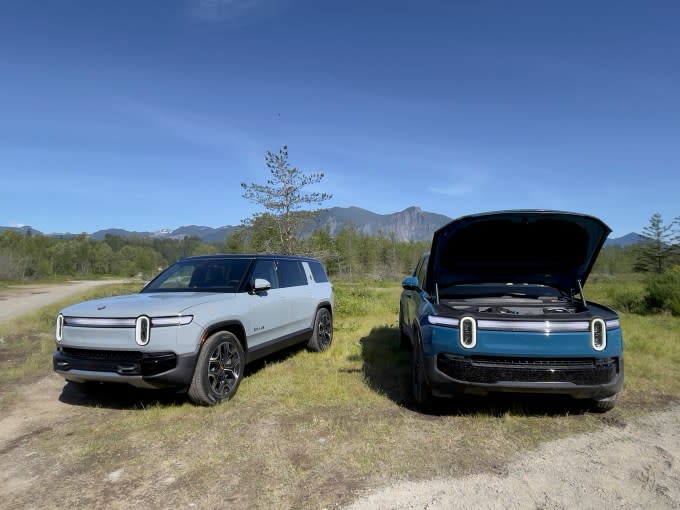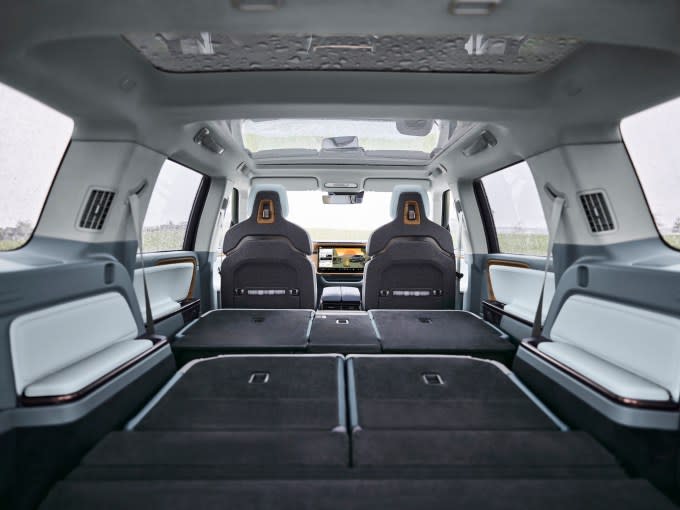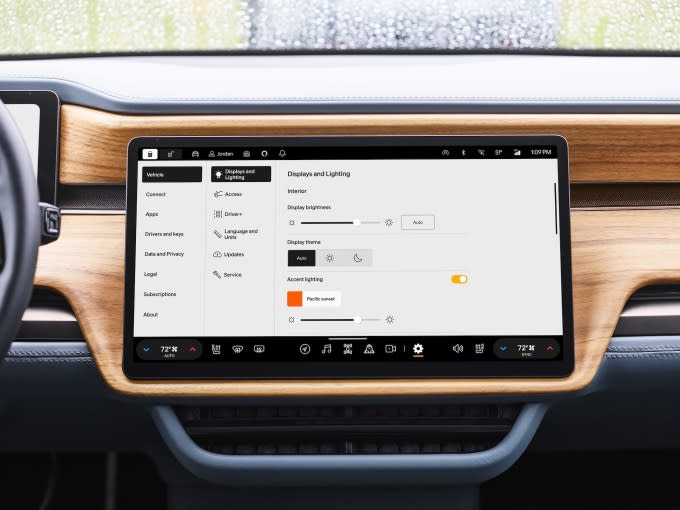Rivian overhauled the R1S and R1T to entice new buyers ahead of cheaper R2 launch
Rivian has changed 600 parts on its R1S SUV and R1T pickup truck in a bid to drive down manufacturing costs, while improving performance of its flagship vehicles.
The end goal, which will play out over the coming year, is an existential one. Rivian lost about $38,784 on every vehicle it delivered in the first quarter of 2024, according to its earnings report. And the automaker won’t have the new, cheaper R2 SUV on the road until the first half of 2026.
That leaves Rivian with one route: sell more R1S and R1T vehicles without losing money.
The clock starts now. Rivian has recently started producing the second-generation R1T and R1S, with the first deliveries beginning as early as this week.
The result of Rivian’s second-generation reboot is an all-electric truck and SUV with improved ride quality, more powerful drivetrain options and other bells and whistles, including an electronically tinted sunroof and a so-called “launch mode” that can catapult the new R1T quad-motor trim from a standstill to 60 miles per hour in less than 2.5 heart-pumping seconds.
But you wouldn’t know any of this just by looking at the second-generation EVs.
Rivian has left the exterior of the second-generation R1 line mostly untouched — with the exception of a new lighting feature that provides a charging status bar across the front, Storm Blue paint color and wheels — a decision that executives told TechCrunch was intentional.

Instead, Rivian has focused its efforts on reworking the guts, changing everything from the battery pack and suspension system to the electrical architecture, interior seats and sensor stack. There’s even a redesigned software user interface that provides detailed illustration-like graphics using Unreal Engine as well as deeper integration with Apple and Google.
“Some changes are small, some changes are big, but every single aspect of the experience of the R1 will improve with this platform,” Rivian’s head of software, Wassym Bensaid, told reporters in a media briefing ahead of the official launch.
Vertical integration is the underlying theme here. Rivian still has suppliers. But its engineers, designers and factory workers are responsible for making more parts of the R1 EVs than ever before.
Rivian now designs, engineers and makes its motors in house, for example. The company is also responsible for redesigning a heat pump-based thermal system to improve rider temperature comfort and saving range, and for developing a new electrical architecture and compute platform that reduces the number of electronic control units (ECUs) used to control the vehicle from 17 different ECUs in its first generation to seven. This new zonal architecture allows Rivian to cut more than 1.6 miles of wiring from each vehicle — a 44-pound weight savings — and to build its vehicles faster, according to director of electrical systems Kyle Lobo.
Rivian says it even internally developed the 11 new high-resolution cameras that, along with five radar, make up its perception stack and support its safety and advanced driver assistance system.

Drivetrains and batteries
The second-generation Rivian R1 lineup has four primary configurations: dual-motor, performance dual-motor, tri-motor and quad-motor. Once a customer moves beyond the drivetrain, there is an array of battery pack options and other features that pushes the price tag ever higher. Rivian has also redesigned the battery modules in the large and max battery packs, which executives say make them easier to build and service.
Both the dual-motor and performance dual-motor drivetrains can be configured with three different battery packs. The base version, the dual-motor with a standard battery pack, starts at $69,900 for the R1T and $75,900 for the R1S. Notably, this version is outfitted with a lithium-iron phosphate-based battery that provides an EPA-estimated 270 miles of range.
From here, the battery ranges and the prices tick higher with the dual-motor large pack and dual-motor max pack trims. The R1T dual-motor and performance dual-motor with a max pack gets 420 miles of range. The R1S, in a similar configuration, can travel an estimated 410 miles on a single charge.
Rivian has dialed up the options by adding a tri-motor drivetrain trim — only available with the max battery pack — that uses two motors in the rear and one in the front. This combo delivers 850 horsepower, 1,103 pound-feet of torque and a zero-to-60 mph time of 2.9 seconds. The tri-motor max pack trim, which has an estimated range of 380 miles, starts at $99,900 for the R1T and $105,900 for the R1S.
Rivian rounds out its offerings with a quad-motor max pack trim, which delivers an eye-popping 1,025 horsepower, 1,198 pound-feet of torque and an off-the-line to 60 mph acceleration time of less than 2.5 seconds when using the so-called “launch mode” feature.

Google, Apple and autonomy
Rivian has put effort towards developing and improving its own software stack, which includes everything related to real-time operating systems (RTOS) that manage the car, such as thermal dynamics, ADAS and safety systems, as well as another layer related to the infotainment system.
Engineers use free RTOS and safe RTOS as the basis of its operating system for vehicle controls.
Meanwhile, Rivian’s infotainment system has two operating systems. QNX is the host operating system, which is only used for safety functions, and an open source version of Android Automotive for everything else. Bensaid said the company is moving away from QNX to a Linux-based software.
On the autonomy front, Rivian uses a combination of Linux and free RTOS software.
“It’s been really a continuation; since day one we’ve been super intentional about owning our own ECUs, our own computers, and our own software,” Bensaid said, describing the company’s long-term approach. “Gen one was ramping up the internal knowledge to get to a domain-based architecture. And now that we have those foundations, we’re able to move to a zonal-based architecture, which is much more challenging from a technical standpoint.”
Only two companies — Rivian and Tesla — have a true zonal architecture, Bensaid claimed.
“This is what the industry is calling software-defined vehicles — a term that is absolutely abused,” he added.
The company has also developed its own middleware software, which communicates with the real-time ECUs, the infotainment ECUs and the cloud.
These deep-in-the-weeds details matter because theoretically, Bensaid explained, Rivian can take any function in the infotainment system and bring it over to a mobile phone or a third-party application. In other words, this allows for customers to have a connected car and hints that Rivian could develop its own app store while maintaining security.
All of this effort shows Rivian’s extreme interest in controlling the entire experience. So, perhaps it’s not surprising that Rivian’s second-generation R1 line does not offer the popular smartphone projection features of Apple CarPlay or Android Auto. And it likely never will, according to Bensaid.
Instead, Rivian is working with Google and Apple to integrate the products that customers want most: music, maps and messaging. For instance, Rivian owners will now be able to use car keys in Apple Wallet on iPhone and Apple Watch, or with select Google Pixel devices, to unlock and start up their vehicles or share keys digitally.
Rivian is also launching a new subscription service called Connect+ that will give customers access to more Apple and Google products for $14.99 per month, or $149.99 annually. Later this summer, Connect+ customers will be able to stream video (while parked) via Googlecast, which includes 3,000 apps as well as access to Apple Music. Rivian also worked with Apple to bring its Spatial Audio with Dolby Atmos to the car.
Connect+ subscribers will also have access to Spotify, Tidal and Alexa and have the ability to share their WiFi hotspot with up to eight devices.
Rivian said it also plans to integrate voice assistants Siri and Google Assistant in the vehicles.
The company has taken a similar in-house-is-best approach to its “Rivian Autonomy Platform,” which will come standard on all second-gen R1 vehicles and includes 11 cameras, five radar sensors and a computer that is 10 times more powerful than the previous system.
Rivian may use the word “autonomy” but its system is not self-driving, or even close. The advanced driver assistance system, which TechCrunch tested, requires the driver to remain alert with their hands on the wheel.
The system includes adaptive cruise control, which maintains speed and distance behind vehicles on the highway, and a highway assist feature that automatically steers, brakes and accelerates on select highways.
Rivian is also releasing a premium version called Rivian Autonomy Platform+, which will be offered for free to second-generation R1 customers for one year. Later this summer, the system will roll out a lane change on command feature that will automatically move the vehicle into another lane when the driver activates the blinker.

 Yahoo News
Yahoo News 
